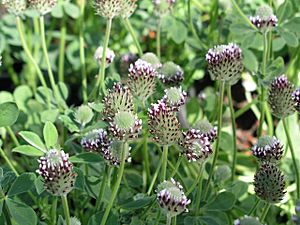Showy Indian clover facts for kids
Quick facts for kids Showy Indian clover |
|
|---|---|
 |
|
| Conservation status | |
| Scientific classification | |
| Genus: |
Trifolium
|
| Species: |
amoenum
|
The Trifolium amoenum, also known as showy Indian clover or two-fork clover, is a special plant found only in California. It's an endangered plant that lives for just one year (an annual herb). You can find it in grassland areas around the San Francisco Bay Area and the northern California Coast Ranges.
What Does It Look Like?
This beautiful wildflower stands up tall. It usually grows in thick soils in places that are less than 100 meters (about 330 feet) above sea level. Its flower head is shaped a bit like a ball and is about 2.5 centimeters (1 inch) wide. The petals are a lovely purple color, fading to white tips.
History of the Clover
A scientist named Edward Lee Greene first collected a sample of this plant in 1890. He found it in Vacaville, California, which is in Solano County.
Long ago, the showy Indian clover grew in many places. Its natural home stretched from the western part of the Sacramento Valley all the way to Marin and Sonoma Counties. But as more cities and farms were built, many of these clover patches disappeared from those areas.
By the mid-1900s, this clover became a rare species because more people were moving into its habitat. By the late 1900s, there were only about 20 groups (populations) of the clover left. This was due to growing towns and new buildings.
Rediscovering the Plant
By 1993, people thought the showy Indian clover was completely gone. The last known group in Vacaville had disappeared. But then, a person named Peter Connors found a single plant in western Sonoma County! This was a huge discovery. Scientists used seeds from this one plant to grow more clovers.
Sadly, the area in Sonoma County where that single plant was found has now been developed. Any clovers that were there have disappeared from that spot. Today, there is only one known group of these clovers left in the wild. It was found in 1996 in northern Marin County and has about 200 plants.
In 1997, the Trifolium amoenum was officially listed as a federally endangered species. This means it gets special protection from the government. Scientists at the Bodega Marine Laboratory have been doing important research to help save this rare clover.


